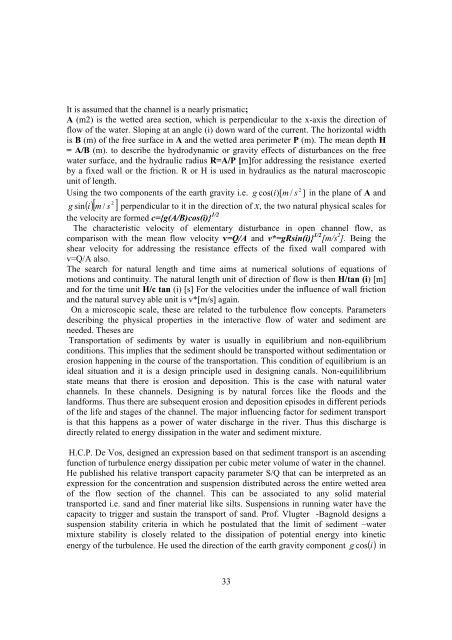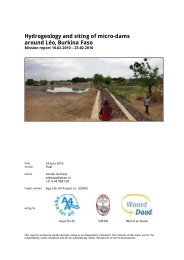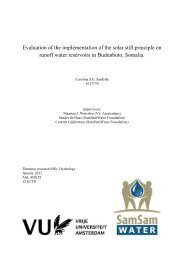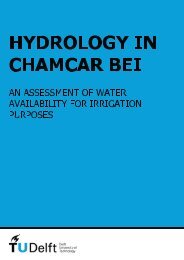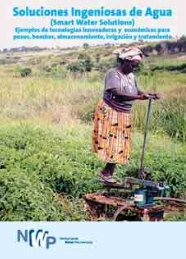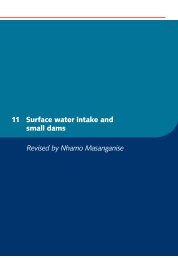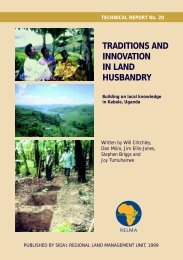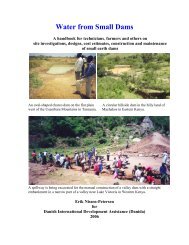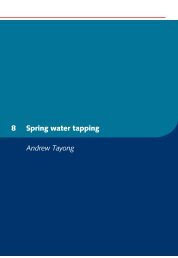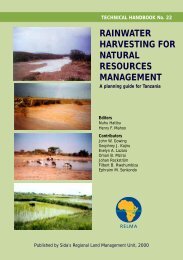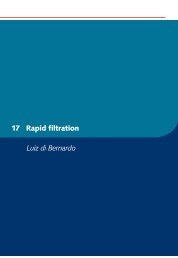KITUI SAND DAMS
Sasol - 2004 - Kitui sand dams Construction and ... - SamSamWater
Sasol - 2004 - Kitui sand dams Construction and ... - SamSamWater
You also want an ePaper? Increase the reach of your titles
YUMPU automatically turns print PDFs into web optimized ePapers that Google loves.
It is assumed that the channel is a nearly prismatic;A (m2) is the wetted area section, which is perpendicular to the x-axis the direction offlow of the water. Sloping at an angle (i) down ward of the current. The horizontal widthis B (m) of the free surface in A and the wetted area perimeter P (m). The mean depth H= A/B (m). to describe the hydrodynamic or gravity effects of disturbances on the freewater surface, and the hydraulic radius R=A/P [m]for addressing the resistance exertedby a fixed wall or the friction. R or H is used in hydraulics as the natural macroscopicunit of length.2Using the two components of the earth gravity i.e. g cos( i)[m / s ] in the plane of A and2( i)[ m / s ]g sin perpendicular to it in the direction of x, the two natural physical scales forthe velocity are formed c={g(A/B)cos(i)} 1/2The characteristic velocity of elementary disturbance in open channel flow, ascomparison with the mean flow velocity v=Q/A and v*=gRsin(i)} 1/2 [m/s 2 ]. Being theshear velocity for addressing the resistance effects of the fixed wall compared withv=Q/A also.The search for natural length and time aims at numerical solutions of equations ofmotions and continuity. The natural length unit of direction of flow is then H/tan (i) [m]and for the time unit H/c tan (i) [s] For the velocities under the influence of wall frictionand the natural survey able unit is v*[m/s] again.On a microscopic scale, these are related to the turbulence flow concepts. Parametersdescribing the physical properties in the interactive flow of water and sediment areneeded. Theses areTransportation of sediments by water is usually in equilibrium and non-equilibriumconditions. This implies that the sediment should be transported without sedimentation orerosion happening in the course of the transportation. This condition of equilibrium is anideal situation and it is a design principle used in designing canals. Non-equililibriumstate means that there is erosion and deposition. This is the case with natural waterchannels. In these channels. Designing is by natural forces like the floods and thelandforms. Thus there are subsequent erosion and deposition episodes in different periodsof the life and stages of the channel. The major influencing factor for sediment transportis that this happens as a power of water discharge in the river. Thus this discharge isdirectly related to energy dissipation in the water and sediment mixture.H.C.P. De Vos, designed an expression based on that sediment transport is an ascendingfunction of turbulence energy dissipation per cubic meter volume of water in the channel.He published his relative transport capacity parameter S/Q that can be interpreted as anexpression for the concentration and suspension distributed across the entire wetted areaof the flow section of the channel. This can be associated to any solid materialtransported i.e. sand and finer material like silts. Suspensions in running water have thecapacity to trigger and sustain the transport of sand. Prof. Vlugter -Bagnold designs asuspension stability criteria in which he postulated that the limit of sediment –watermixture stability is closely related to the dissipation of potential energy into kineticg cos i inenergy of the turbulence. He used the direction of the earth gravity component ( )33


